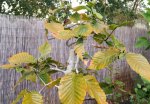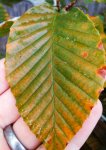JudyB
Queen of the Nuts
They can be wonderful trees, just a bit tricky. Be careful of ferts early in the spring before leaves harden.
Keep us updated!
Keep us updated!
Son of a beech? Or is it a son of a birch? It could be the best ash that a bird dips his pecker into...BTW: This will be great in a couple of years. Is that a son of a beech next to it?
Yes, burning. The way they store/use salts is different than most trees. I would not use a chemical fert early for sure. Also you may want to use Kanuma soil, or at least incorporate it in your mix. I've got mine (EU) in almost straight kanuma, and the leaves are so much better now. I used to have problems with leaf health, but the things I've learned have cured that issue. The other issue is wind. Keep it out of the wind before leaves harden.Would you get burning, or too large leaves?



Judy is spot on,mine never grew well in my standard mix that all my other deciduous trees grew in,even with pine bark added,I decided one spring to mix leaf mold from the woods behind my house where they were collected into the mix,that was the missing link for me,they started to grow strong and look healthy that season,never tried kanuma,but sounds like a winner.
I spoke with an accomplished bonsai expert at the ABS Symposium in June and that person feels that generally the leaves are too large and difficult to reduce. However one may be able to find trees with genetically smaller leaves that make good bonsai.
I agree they are beautiful and easy to grow.



I've collected several and lost a few trying to move them along as fast as my other collected deciduous trees. They definitely need more time to get established after collection. The one I'm working on now is three years post collection, and just had it's first strong summer of growth. I may start working it next spring.
How did you get that leaf so small?
ctually that's another native-a large Bradford pear
